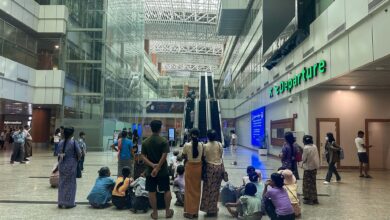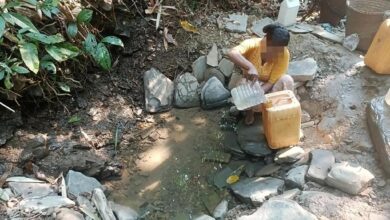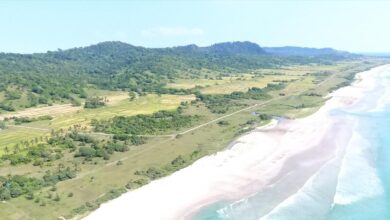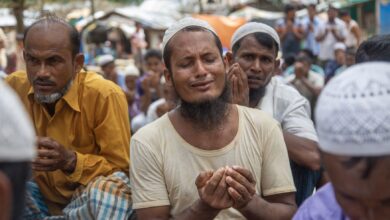
Late last year, 20-year-old Khant Soe Thant was dreaming of starting his own air-conditioner repair business once the Covid-19 pandemic was finally over. But just one month into a year that started with the promise of better times ahead, his dreams were shattered by the Myanmar military’s February 1 coup.
Like countless others around the country, his response to the coup was outrage. That’s why, from the first week of February, he started joining anti-coup protests in Taze, a small town in Sagaing region more than 19km from the village where he lived.
He was so determined to make his voice heard that he made this trip four times a week for the next two months. Then, on April 7, he was finally silenced.
It was on that day that Khant Soe Thant became one of more than a dozen people killed by the junta’s forces as they moved in to crush local opposition to military rule.
“He said that we all need to make sacrifices. And so he sacrificed,” said his father, recalling how Khant Soe Than, who had been shot in the chest, came back to his home as a lifeless body late that night.
‘Shooting with a vengeance’
The protests in Taze attracted more people than the entire population of the town itself. Residents of smaller communities in the surrounding area had filled the town’s streets in their tens of thousands almost daily since the coup.
At least half of those killed on April 7 were villagers from places like Inn Shay, Pauk Taw, Tway Di, Nanwintaw, Aung Chan Tha, and Kywe Swea, who had come together to show their solidarity with the rest of the nation.
For two months, no serious clashes were reported in Taze because the protesters had managed to avoid directly confronting the junta’s armed forces.
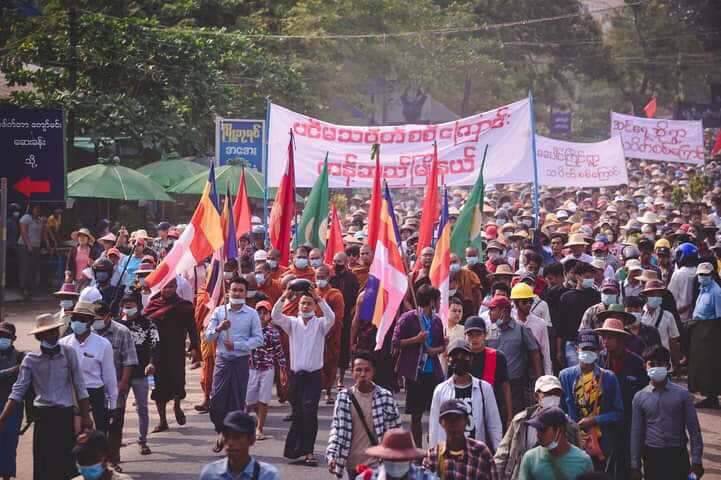
But that situation came to an end a week into April, as the junta turned its attention to the town after carrying out a major crackdown on another Sagaing anti-coup stronghold in Kalay.
On April 7, the protesters in Taze received word that six military trucks were on their way from Ye-U, about 20km to the south. Fearing the worst, they immediately started creating as many obstacles as they could on the road between the two towns.
Villagers cut down trees and laid them in the path of the oncoming convoy. They also used stones to impede its progress. But by 3pm, the trucks full of heavily armed soldiers had reached Tanae, just over a kilometre away.
The soldiers set fire to the protesters’ barricades. Then, as black smoke rose from the piles of sandbags and burning tires that were the town’s last defence, they opened fire.
“They fired on civilians as if they were in a real war, not like they were trying to break up a crowd. They were just shooting at us with a vengeance,” said one protest leader.
Using snipers, machine guns and heavy artillery, the soldiers easily overpowered the protesters, who fought back with homemade guns with a range of no more than 200 meters. Some also had air guns, but these were far from lethal.
‘Never surrender’
The crackdown continued for around three hours. In addition to those who were killed, at least 20 were injured. Many others narrowly escaped.
“A guy in front of me was hit in the stomach. When I tried to help him, a bullet grazed my neck. I covered my wound and got out of there as quickly as I could. A motorcyclist picked me up and took me to my home,” said one protester who was involved in the clash near Tanae.
Many of those killed were shot by regime forces that were already present in Taze, according to residents. While most of the protesters were busy resisting the troops that were coming in from Ye-U, the junta’s armed forces in the town started firing on civilians who stayed behind, they said.
Most of the bodies were collected by the protesters that night; more were found in fields around the town the next morning, according to social relief groups.
Those who were wounded have had to go into hiding to receive treatment, due to doctors’ fears that they or their patients could be targeted.
On the morning after the crackdown, a charity clinic set up for the injured at the Pinsaw monastery was raided by soldiers for nearly two hours. According to a resident, the troops seized both cash and rice from the clinic before leaving.
With more than 100 soldiers currently stationed near Taze’s statue of independence leader General Aung San and troops patrolling the town, the protests have come to a halt.
Meanwhile, mobile internet restrictions have made it impossible to get news from the rest of the country, prompting some to travel to Ye-U, where cable internet connections are available.
Despite the heavy military presence in the town and the arrest of many who took part in the protests, leaders of the local anti-coup movement say they will continue with their efforts to resist the regime.
“The people will never surrender and will never tolerate the junta’s oppression. The people of Taze will continue to do whatever they can,” said one protest leader.
